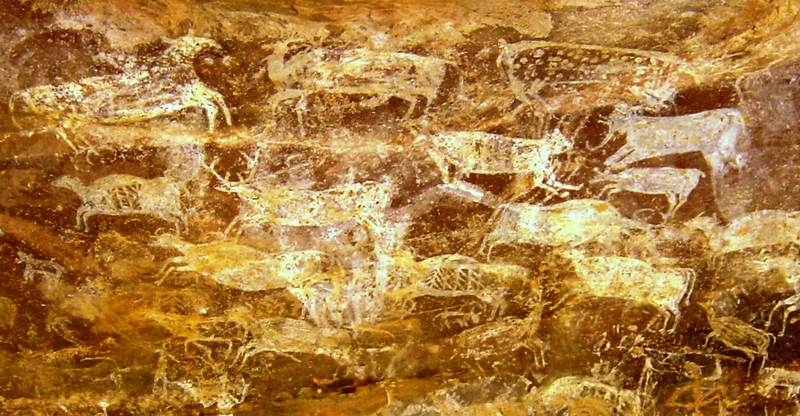Sound Illusions: Eerie Echoes May Have Inspired Prehistoric Cave Art

Humankind has a long-standing affinity for art. As far back as 40,000 years ago, people were decorating cave walls in Indonesia and in Europe, often with panoramas of thundering herds of wildlife. Now, a growing line of research suggests that the "thundering" part of that description is no coincidence.
Echoes, reverberations and other then-inexplicable auditory illusions may have inspired mankind's earliest artists, according to Steven Waller, a researcher at Rock Art Acoustics in La Mesa, California. In a talk to be presented today (Oct. 28) in Indianapolis, Indiana, at the annual meeting of the Acoustical Society of America, Waller weaves together a theory of ancient art that focuses as much on sound as on sight.
"Today, we know about sound waves," Waller told Live Science. Prehistoric people did not. To them, echoes might be the voices of spirits and reverberations the sounds of thunder gods — notions enshrined in traditional mythologies passed down around the world.
"We know that in the past people considered these sounds to be highly significant," Waller said. [The 7 Most Mysterious Archaeological Finds on Earth]
Piper's stones and echoing caves
Waller's work spans the globe, from paleo-art in North America to stone circles in the United Kingdom. In 2012, he reported a startling acoustical discovery about Stonehenge, the famed stone circle in Wiltshire, England. The stones in Stonehenge create acoustical dead spots, Waller found, very similar to acoustical dead spots created when two pipers stand in a field and play a note simultaneously. The interference of sound waves creates spots in the field where the noise cancels out.
Stone circles like Stonehenge are also known as "piper's stones," Waller pointed out, and they are the center of a myth about magical pipers playing for a circle of dancing maidens, all of whom turned to stone at the sound of the music. It's that mythology that leads Waller to believe that Stonehenge may have been built to mimic an acoustical illusion. [Stonehenge: 7 Reasons the Mysterious Monument Was Built]
Get the world’s most fascinating discoveries delivered straight to your inbox.
Myth and sound collide at other sites, as well. European cave art is dominated by pictures of herds of bison, stags and other large mammals, Waller said. In Eurasia, these animals are also associated with thunder gods, because the sound of hundreds of hoofs was thunderous.
Thus, Waller argues, it's no coincidence these animals are painted in caves where the echoes reverberate so much that a few sounds quickly escalate into a thunderous roar. His measurements bear this out: He has found that cave areas with a higher level of reverberation are more likely to be decorated with art.
Spirits in rock
The same is true in North America, Waller said, where reverb-rich locations are frequently decorated with illustrations of thunderbirds, a legendary creature whose wings were thought to cause the sound of thunder. In the Canadian Shield, a rock layer formed some 500 million years ago, myths tell of rock-dwelling spirits called Memegwashio that are responsible for both echoes and rock art.
"They say, 'They leave their bloody handprints when they close the door behind them,'" Waller said of the Memegwashio myths.
In canyons, as well, Waller has found the correlation between spots with lots of echoes and spots where prehistoric art is found. In a few cases, he and his colleagues have even started by picking out spots rich in echoes and found previously undiscovered art, he said.
It might seem far-fetched that ancient people followed sounds so closely, but that's because people today tend to downplay sound, Waller said.
"We just kind of write it off, we just trivialize it — 'That's just an echo or an interference,'" he said. But for a prehistoric person, echoes would have been as mysterious as quantum physics is to the average person today, he said. And even now, a surprising sound, whether it's an unseen person suddenly speaking from just behind you or a creaking floorboard in a supposedly empty house, can be quite spooky.
"It's a trivial little sound, but it can have a huge emotional impact if you don’t expect it, if you can't explain it," Waller said.
Waller isn't the only researcher beginning to investigate the acoustics of ancient sites. The field of acoustic archaeology is growing as researchers increasingly take sound into account in their excavations. In Peru, for example, the pre-Inca ceremonial site of Chavín de Huántar features labyrinths that would have created bizarre, disorienting echoes. According to the research team, instruments called pututus, made of conch shells, have been found at the site, revealing the importance of sound in ancient rituals.
Another Stonehenge study, released in 2012, found that the complete stone circle would have had amazing acoustics that would have reflected sound like a modern lecture hall. Though the researchers did not go as far as to say that acoustics motivated the construction of Stonehenge, they suggested that the site's sound properties could have affected how it was used.
Follow Stephanie Pappas on Twitterand Google+. Follow us @livescience, Facebook& Google+. Original article on Live Science.

Stephanie Pappas is a contributing writer for Live Science, covering topics ranging from geoscience to archaeology to the human brain and behavior. She was previously a senior writer for Live Science but is now a freelancer based in Denver, Colorado, and regularly contributes to Scientific American and The Monitor, the monthly magazine of the American Psychological Association. Stephanie received a bachelor's degree in psychology from the University of South Carolina and a graduate certificate in science communication from the University of California, Santa Cruz.


